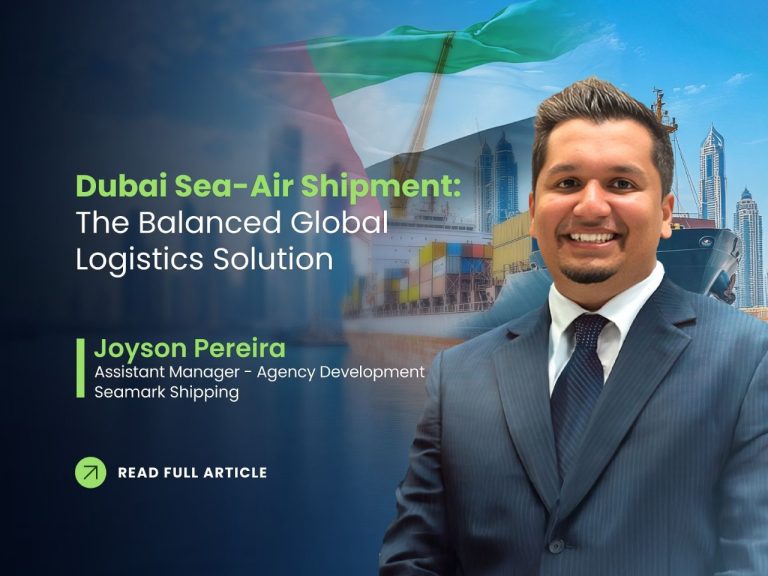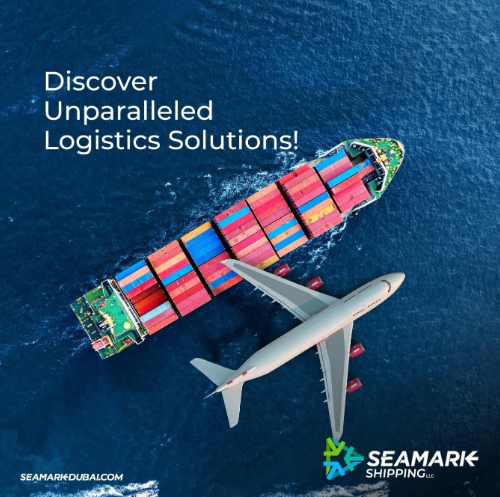By Joyson Pereira, Assistant Manager-Agency Development of Seamark Shipping in Dubai

In the current global shipping environment, logistics providers face mounting challenges that require adaptable solutions. Recent disruptions in the Red Sea have created significant obstacles for freight forwarders worldwide. These complications have affected delivery schedules and caused price increases beyond client budgets. In response, forward-thinking logistics companies are implementing alternative transportation methods that maintain service quality while managing costs.
Sea-Air Shipment combines the best of both worlds – the speed of air freight and the economy of sea freight – to offer a cost-effective and efficient transportation solution. Dubai, with its unrivalled connectivity and strategic location, serves as the perfect gateway for global logistics. This innovative service leverages Dubai’s world-class infrastructure to offer a practical blend of sea and air transportation options, providing faster transit times and cost-effective solutions.This hybrid approach uses maritime shipping for the initial segment of cargo journeys, followed by air freight for the final distribution phase. The method creates a middle-ground option that addresses both time and budget constraints that many shippers currently face.The concept works by utilizing ocean vessels for the longer portion of the journey, typically from manufacturing origins to a central hub. From this transfer point, goods move to aircraft for rapid delivery to final destinations. This approach reduces transit times compared to exclusive sea freight while keeping costs significantly lower than pure air shipments.
The success of any Sea-Air Shipment program depends heavily on the transfer hub’s capabilities. Several factors position Dubai as the premier location for such operations:
Dubai’s position at the crossroads of Europe, Asia, and Africa establishes it as an ideal hub for global logistics. This central location ensures efficient connectivity to major destinations worldwide, reducing overall transit distances for many international routes.
As a hub, Dubai offers expedited transit times that enable organizations to meet tight deadlines and maintain efficient supply chain operations. The rapid processing and transfer capabilities significantly reduce dwell time between transportation modes.
By combining sea and air transportation modes through Dubai, logistics providers can offer competitive pricing while still delivering cargo with the speed and reliability that clients expect. This balance often results in 30-50% cost reduction compared to pure air freight options.
Dubai boasts state-of-the-art logistics infrastructure, including world-class ports and airports, as well as efficient customs procedures, ensuring smooth and efficient cargo handling. Seamark Shipping’s extensive facilities in Dubai make it an optimal transfer point for global shipments, with a 75,000 square meter logistics facility in JAFZA and 5,000 square feet of dedicated space at Dubai Cargo Village/DAFZA. This impressive capacity and strategic positioning makes Seamark’s Dubai operation the perfect choice for seamless Sea-Air transfers.
Seamark’s operations in Dubai are supported by a dedicated team of 150 experts proficient in handling a wide range of freight, including certified dangerous goods specialists. This team is committed to providing personalized service and end-to-end support, ensuring a hassle-free shipping experience for clients worldwide.
These advantages create a logistics environment where cargo can move between transport modes with minimal delay. When goods arrive at Dubai ports, they undergo swift processing before transfer to air cargo facilities. This reduces total transit time while maintaining cost advantages.re transfer to air cargo facilities. This reduces total transit time while maintaining cost advantages.
Organizations implementing Sea-Air Shipment report numerous operational advantages. The primary benefits include balanced cost management and improved delivery reliability.
Traditional ocean shipping often takes 30-45 days for intercontinental routes. Full air freight can reduce this to 3-5 days but at premium prices. Sea-Air Shipment combinations typically achieve 14-18 day transit times—approximately half the duration of sea freight while costing 30-50% less than air-only options.
This middle-ground position helps organizations balance budget limitations against time requirements. Companies with products too valuable for slow sea transit but unable to absorb full air freight costs find this option particularly valuable.
The Red Sea disruptions have demonstrated the importance of flexible shipping strategies. Sea-Air Shipment programs provide an alternative pathway that avoids troubled shipping lanes while maintaining reasonable delivery schedules. This diversification reduces vulnerability to regional conflicts, port congestion, or other supply chain disruptions.
The combined approach also offers potential environmental benefits compared to exclusive air freight. The sea portion generates significantly lower carbon emissions per ton-mile than air transport. Organizations with sustainability commitments can reduce their carbon footprint while still achieving acceptable transit times.
Supply chain managers considering Sea-Air Shipment should evaluate several factors before implementation:
The approach works particularly well for specific cargo profiles: high-value goods, products with moderate time sensitivity, and items with production origins in Asia destined for European or African markets.
Modern Sea-Air Shipment depends on advanced tracking systems and integration between maritime and aviation logistics networks. Leading providers employ unified digital platforms that maintain visibility throughout the entire journey. These systems allow for:
This technological foundation ensures that cargo transitions smoothly between transportation methods without information gaps or coordination failures.
The complexity of dual-mode shipping requires specialized expertise. Professional logistics teams managing sea-air programs need comprehensive understanding of:
Service providers with dedicated specialists, including certified dangerous goods handlers, offer additional value by managing complex shipments that might otherwise require exclusive air freight.t.

The evolution of supply chain practices continues to favor flexible, resilient approaches. Sea-Air Shipment represents a practical response to current market conditions that will likely remain relevant as companies seek balanced transportation solutions. The continued development of Dubai’s logistics infrastructure further strengthens this position.
As global trade patterns shift and new challenges emerge, the advantages of multi-modal shipping through strategic hubs will become increasingly apparent. Organizations that incorporate these approaches now gain both immediate benefits and future-ready supply chain structures.
Subscribe our newsletter and stay updated for special offer!
Copyright 2022 | Seamark Dubai – Designed and Developed By Vibrand 360
WhatsApp us